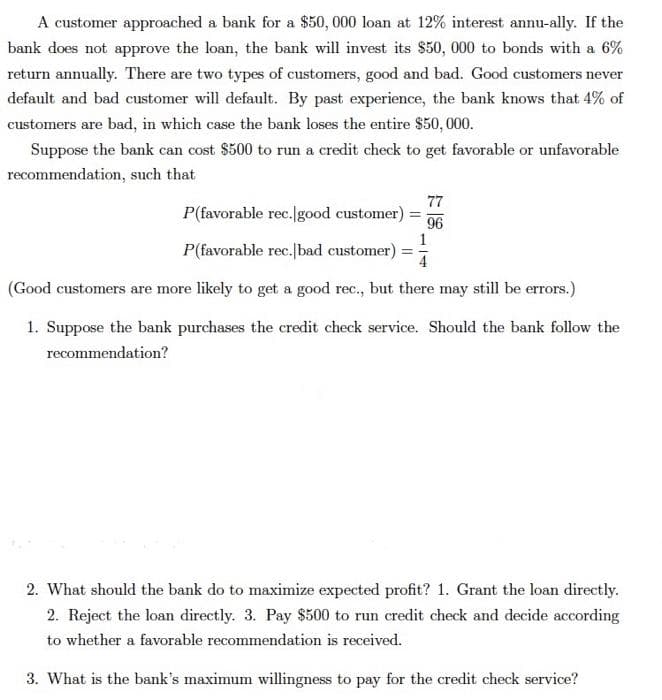A customer approached a bank for a $50, 000 loan at 12% interest annu-ally. If the bank does not approve the loan, the bank will invest its $50, 000 to bonds with a 6% return annually. There are two types of customers, good and bad. Good customers never default and bad customer will default. By past experience, the bank knows that 4% of customers are bad, in which case the bank loses the entire $50, 000. Suppose the bank can cost $500 to run a credit check to get favorable or unfavorable recommendation, such that 77 P(favorable rec.good customer) 96 P(favorable rec.[bad customer) (Good customers are more likely to get a good rec., but there may still be errors.) 1. Suppose the bank purchases the credit check service. Should the bank follow the recommendation? 2. What should the bank do to maximize expected profit? 1. Grant the loan directly. 2. Reject the loan directly. 3. Pay $500 to run credit check and decide according to whether a favorable recommendation is received. 3. What is the bank's maximum willingness to pay for the credit check service?
A customer approached a bank for a $50, 000 loan at 12% interest annu-ally. If the bank does not approve the loan, the bank will invest its $50, 000 to bonds with a 6% return annually. There are two types of customers, good and bad. Good customers never default and bad customer will default. By past experience, the bank knows that 4% of customers are bad, in which case the bank loses the entire $50, 000. Suppose the bank can cost $500 to run a credit check to get favorable or unfavorable recommendation, such that 77 P(favorable rec.good customer) 96 P(favorable rec.[bad customer) (Good customers are more likely to get a good rec., but there may still be errors.) 1. Suppose the bank purchases the credit check service. Should the bank follow the recommendation? 2. What should the bank do to maximize expected profit? 1. Grant the loan directly. 2. Reject the loan directly. 3. Pay $500 to run credit check and decide according to whether a favorable recommendation is received. 3. What is the bank's maximum willingness to pay for the credit check service?
Chapter12: Sequences, Series And Binomial Theorem
Section12.3: Geometric Sequences And Series
Problem 12.58TI: What is the total effect on the economy of a government tax rebate of $500 to each household in...
Related questions
Question

Transcribed Image Text:A customer approached a bank for a $50, 000 loan at 12% interest annu-ally. If the
bank does not approve the loan, the bank will invest its $50, 000 to bonds with a 6%
return annually. There are two types of customers, good and bad. Good customers never
default and bad customer will default. By past experience, the bank knows that 4% of
customers are bad, in which case the bank loses the entire $50, 000.
Suppose the bank can cost $500 to run a credit check to get favorable or unfavorable
recommendation, such that
77
P(favorable rec.good customer)
96
1
P(favorable rec.|bad customer) =
4
(Good customers are more likely to get a good rec., but there may still be errors.)
1. Suppose the bank purchases the credit check service. Should the bank follow the
recommendation?
2. What should the bank do to maximize expected profit? 1. Grant the loan directly.
2. Reject the loan directly. 3. Pay $500 to rum credit check and decide according
to whether a favorable recommendation is received.
3. What is the bank's maximum willingness to pay for the credit check service?
Expert Solution
This question has been solved!
Explore an expertly crafted, step-by-step solution for a thorough understanding of key concepts.
This is a popular solution!
Trending now
This is a popular solution!
Step by step
Solved in 2 steps with 2 images

Recommended textbooks for you

